Types of Red Berries (With Pictures) – Identification Guide
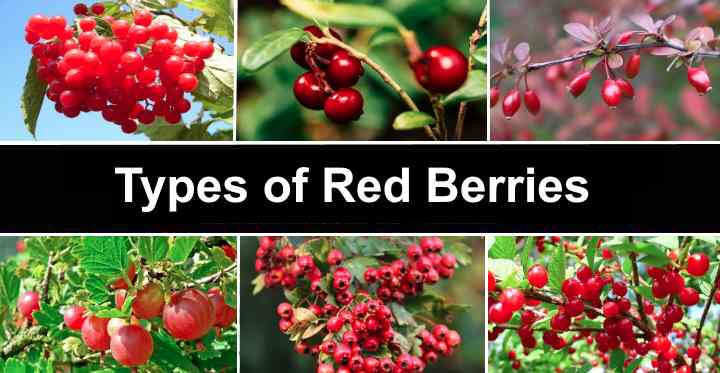
Red berries are common fruits on various types of shrubs, bushes, and trees. Many types of edible red berries have a sweet or tart flavor and taste delicious off the shrub or tree. With their vibrant crimson, scarlet, and maroon colors and delicious flavors, red berries are a popular choice for both cooking and snacking.
Red berries are a diverse group of fruits that come in a range of shapes, sizes, and flavors. From familiar favorites like strawberries, raspberries, and cranberries to lesser-known varieties like goji berries and red chokeberries, there are many types of red berries and berry-like fruits to discover.
Although many varieties of red berries are delicious, there are inedible and toxic types to avoid. For example, red-colored berries from holly shrubs, mistletoe, lily of the valley, and cotoneaster plants are poisonous, and you should never eat them.
Therefore, accurately identifying red berries is vital to differentiate edible fruits from toxic, inedible ones. So, if you are unsure about the variety of plants, you should avoid eating unidentified red fruits to prevent potentially serious consequences.
This article provides a comprehensive guide to identifying red berries found in the wild or in your garden. Descriptions and pictures of different red berries will help you distinguish between poisonous and edible berries and provide tips for enjoying them.
What is a Red Berry?
Botanically speaking, a red berry is “a simple fruit with seeds and pulp produced from a single ovary of a single flower.” Examples of true red berries include gooseberries, grapes, coffee berries, strawberry tree (Arbutus unedo) fruits, and barberries.
However, many people refer to all types of small edible fruits like pomes and drupes as berries, whether they are true berries or not. Also, some red fruits have “berry” in the common name, like strawberry or raspberry. However, they are not berries in the botanical sense.
In this article, we will refer to all small round red fruits that grow on trees, shrubs, and vining plants as berries—regardless of whether they are true berries, pomes, drupes, or aggregate fruits.
Types of Red Berries — Identification Guide with Pictures
Here are descriptions of some of the most popular types of red berries, their unique characteristics, and how to identify them on shrubs, fruit bushes, and trees.
Cranberry (Vaccinium macrocarpon)

Cranberries are small bright red berries that have a distinctly refreshing tart flavor. Red cranberries grow on trailing woody vines or shrubs and turn crimson when they ripen in the fall. Cranberries measure around 0.6” to 1.2” (15 – 30 mm) long. Ripe cranberries are glossy scarlet red, and firm yet bouncy to the touch.
Although you can eat cranberries raw, they are typically too sharp and sour for most people. Therefore, the tart red berries are usually dried or juiced to make them sweeter.
Red Gooseberry (Ribes uva-crispa)
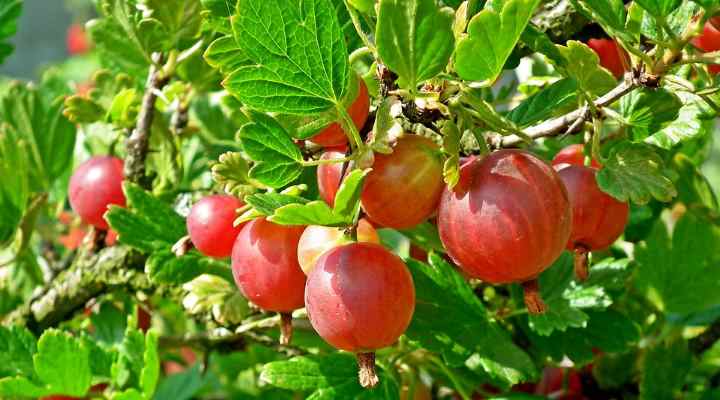
Red gooseberries are large globular fruits with a sweet fleshy center and tart-tasting skin. Depending on the variety, the berries can be dark red or maroon or pale red to dark pink. Red gooseberry fruits have distinctive lighter veins running from top to bottom. The tasty red berries grow on spiny bushes covered in lobbed foliage.
Depending on the cultivar, red gooseberries can grow up to 1” (25 mm) long, and their fleshy pulp contains many seeds. Unlike other currant bushes, gooseberries grow as individual fruits rather than in clusters or bunches. Typical uses for red gooseberries include jams, jellies, juices, and pies.
Lingonberry (Vaccinium vitis-idaea)
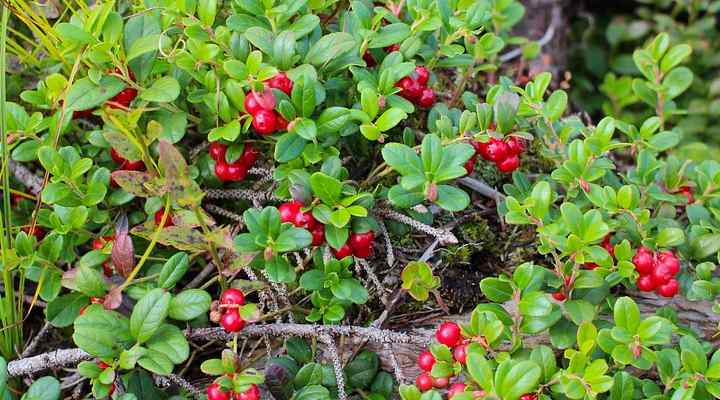
Lingonberry is a small evergreen shrub producing bright red berries. Like related cranberries, the scarlet-red oval to round berries have an acidic, somewhat sour taste. These red berries grow 0.23” to 0.40” (6 – 10 mm) long and ripen in late summer and early fall.
Also called cowberries, lingonberries have a tart and slightly sweet flavor. Therefore, most people avoid eating them raw. Instead, the bitter-tasting berries are perfect for use in jams, sauces, and desserts.
Hawthorn Berry (Crataegus spp.)
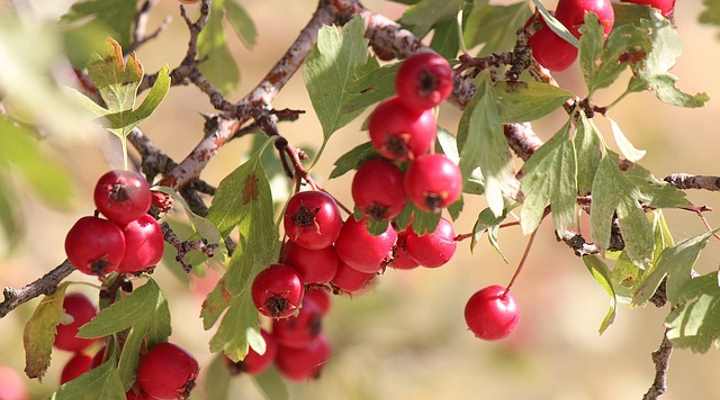
Red berries on hawthorn trees and shrubs are small red drupes that look like berries. The small round fruits dangle on long stems from thorny branches. Resembling tiny crabapples, the red fruits of hawthorn trees grow 0.40” to 0.80” (10 to 20 mm) long. The drupes are edible and popular in jellies, jams, and chutneys.
Hawthorn berries can be eaten straight off the tree. However, like apples, the seeds contain cyanide and shouldn’t be eaten. Additionally, the bunches of red berries resemble rowan tree berries, which need cooking before eating.
Barberry (Berberis spp.)
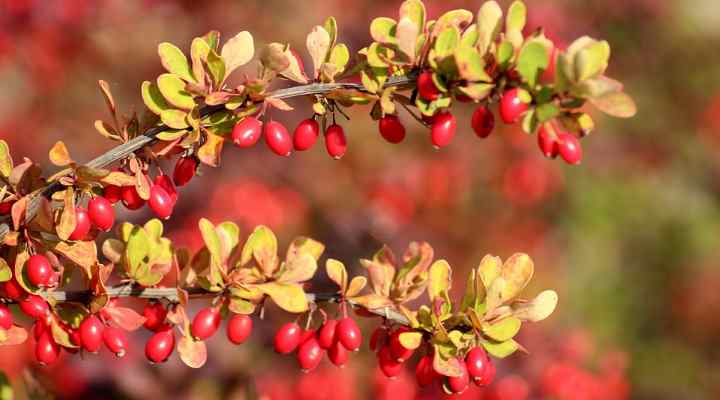
Barberries are small red berries shaped like a tiny American football. The bright crimson fruits measure 0.20” to 0.60” (5 – 15 mm) long and grow on tall evergreen shrubs. The red edible berries develop from yellow flowers and grow abundantly on the bushy berry plants.
Barberries are known for their tart, slightly sweet taste. Depending on the variety, some berries on these thorny hedging plants have tough seeds and a bitter flavor. The red edible berries are typically used in Middle Eastern cuisine or jams.
The danger when foraging for barberries is from the spiny branches that contain long, sharp thorns.
Nanking Cherry (Prunus tomentosa)
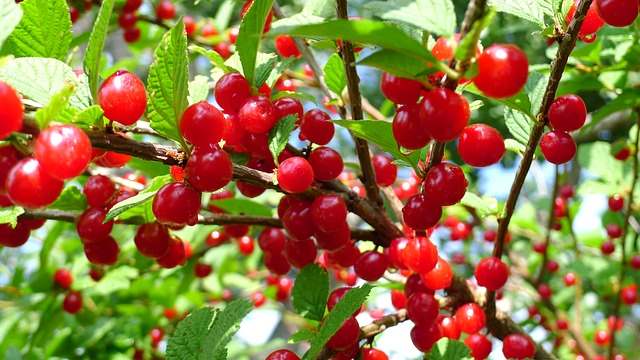
The Nanking cherry tree produces sweet red berry-like drupes that resemble small cherries. The scarlet fruits measure 0.20” to 0.47” (5 – 12 mm) and grow abundantly in early to mid-summer. The round red fruits dangle at the end of long petioles and turn scarlet when ripe in early summer.
Tasty red Nanking cherry fruits have a sweet, slightly tart taste and are popular for use in pies, jellies, or jams. Additionally, its attractive five-petalled white flowers make the berry-producing ornamental shrub useful as a specimen plant in temperate climates.
Nanking cherry trees are ideal for growing as a privacy hedge, shrub border, or specimen plant.
Pin Cherry (Prunus pensylvanica)
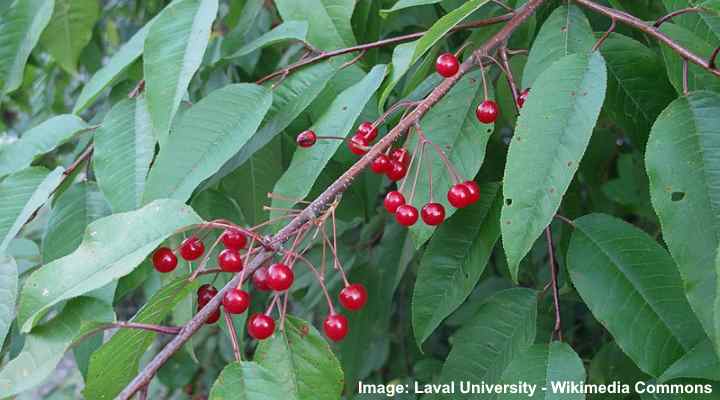
Also called bird cherry or red cherry, the red fruits on the trees are rounded red drupes. These small berry-like fruits measure 0.15” to 0.30” (4 – 8 mm) in diameter, each containing a large, hard seed. These bright red fruits follow clusters of white flowers and ripen in summer and fall.
The round red berry drupes have limited culinary use. The large stone in the rounded red drupes means there is little flesh to use or enjoy. However, the cherry tree has attractive reddish bark, clusters of white flowers, and a round-topped crown, giving it ornamental appeal.
Red Currant (Ribes rubrum)
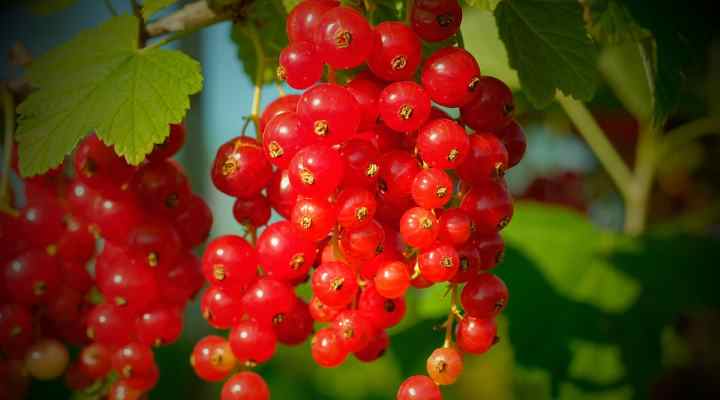
Red currants are popular bright red, translucent berries that grow in dense bunches on small fruit bushes. Also written as redcurrant, the small red berries measure 0.3” to 0.5” (8 – 12 mm) in diameter. Each fruit cluster can have up to ten berries. However, a small currant bush can produce hundreds of clusters in the season.
Like many types of red berries, these shiny fruits have a tangy but somewhat sweet taste. These small, round, and vibrant red berries are used to make jams, jellies, and summer drinks or are eaten raw in salads.
The berries turn bright red when they are ripe in the summer months. Other cultivars of Ribes rubrum produce clusters of white berries.
Buffaloberry (Shepherdia argentea)
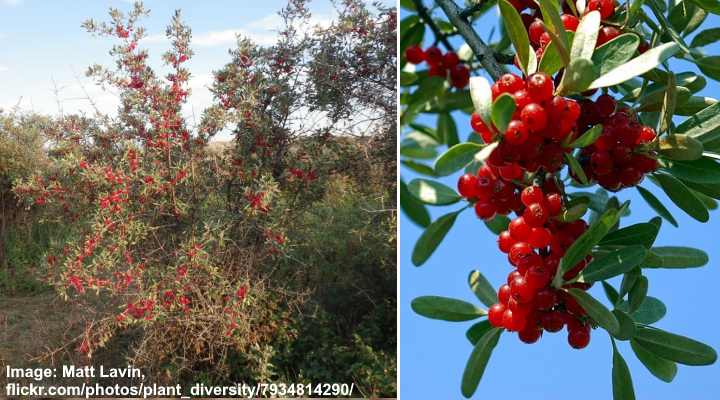
Buffaloberry is a shrub native to North America that produces clusters of bright red berries. Growing on woody stems among oval leaves, the redcurrant-like fruits are small fleshy drupes measuring 0.20” (5 mm). Although the round red fruits are edible, they taste slightly bitter.
Other names for buffaloberry include bull berry or thorny buffaloberry. Although fruit from the thorny shrub is called a berry, the bush produces stone fruits. The tiny red drupes have fleshy pulp surrounding a small stone. The red berries ripen in the fall and are typically used in making jellies, jams, preserves, and pies.
American Mountain Ash (Sorbus Americana)
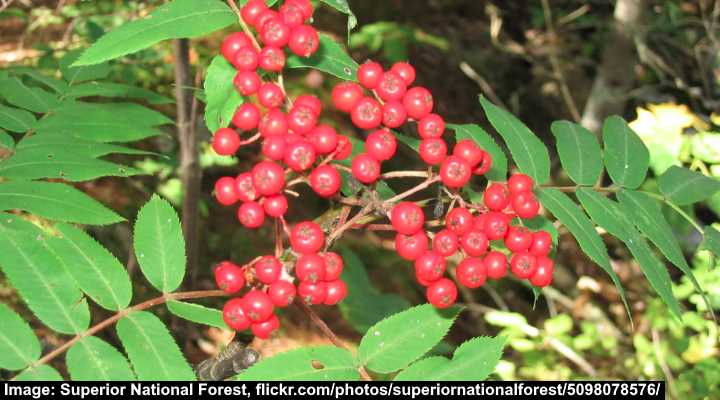
The American mountain ash is a small flowering tree with pinnately compound green leaves and large clusters of red berry-like pomes. The round red fruits are bright red and grow in cymes. These red globular pomes ripen in late fall or early winter and remain on the ash tree until spring.
Also called the rowan tree, the American mountain ash “berries” are edible and are used in jellies or pies. Apart from being popular for human consumption, the abundant red fruits also attract wildlife like moose, deer, and various species of birds.
Additionally, the red berry-like clusters have ornamental value, adding vibrant colors to drab, gray winter landscapes in northern North America.
Salmonberry (Rubus spectabilis)
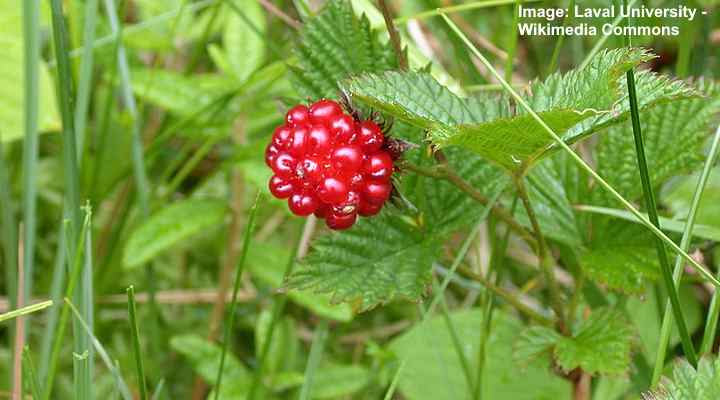
Salmonberries are an unusual type of red fruit growing on large shrubs. Large pinkish-purple flowers develop into shiny red raspberry-like fruits. The large “berries” are 0.5” to 0.75” (15 – 20 mm) long. The tart-tasting fruits are ready for harvesting throughout the summer. Some salmonberry shrubs produce yellow fruits.
Although the fruiting shrub has the name berry, the fruits are not true berries. Instead, they are aggregate fruits like blackberries and raspberries. Uses for the red berry-like fruits include processing into candies, jellies, wine, and jams.
However, you don’t have to eat the red berries to enjoy salmonberry shrubs. The dense green foliage of pointed, triangular leaves, purple flowers, and red summer fruits have great ornamental value for gardens in temperate climates.
Bunchberry (Cornus canadensis)
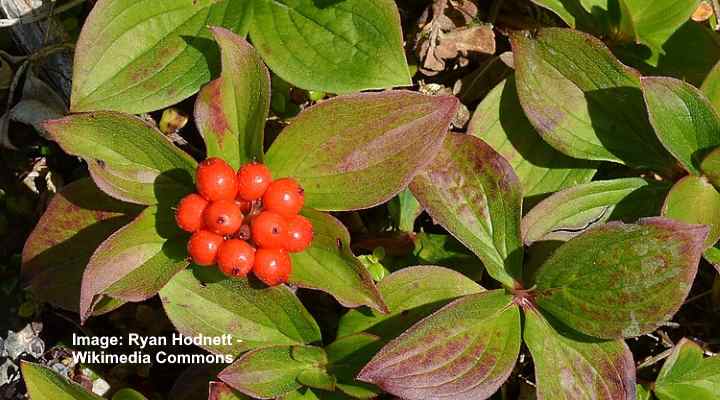
Despite the name bunchberry, red fruits from this low-growing perennial plant are types of stone fruits called drupes. The round berry-like fruits measure 0.20” (5 mm) in diameter and ripen in late summer. After developing from small yellowish-green flowers, the round fruits emerge green before turning bright red when ripe.
Although bunchberries are edible, they have a bland flavor and are not tasty. Therefore, the best use of this creeping perennial is as ground cover in sunny gardens. The four-petalled, white star-shaped flowers provide spring colors, and the ovate leaves turn wine-red to purple in the fall.
However, if you use the red berry-like fruits, you can boil them to make preserves and sauces.
Strawberry (Fragaria × ananassa)

Strawberries are one of the most recognizable red summer berry-like fruits. Although called a berry, the red fruit is not a true berry. Instead, it’s an aggregate accessory red fruit with fleshy pulp surrounded by tiny seeds on the outside. Strawberries can measure 1” to 1.6” (25 – 41 mm) in diameter.
Strawberries are juicy, sweet, delicious fruits that grow on low-growing runner plants. The bright red plump “berries” are typically ready for harvesting in mid to late summer. You can consume strawberries fresh or use them to make jams, and jellies, dip them in chocolate, or decorate cakes.
You can enjoy delicious strawberries by planting various strawberry plant cultivars that ripen at different periods throughout the year. This way, you can have strawberries in your garden from early summer until the first frost.
Raspberry (Rubus spp.)

Raspberries are a type of edible red aggregate fruit that are called berries. The triangular-shaped berry-like fruits grow on woody upright canes. Each fruit measures 0.4” to 1.2” (10 – 30 mm) in diameter and can weigh between 0.11 and 0.18 oz. (3 – 5 g).
Rather than being a single berry with a seed, raspberry fruits consist of hundreds of druplets with juicy pulp and a single seed. This gives the red fruits a distinctive bumpy appearance. A single raspberry bush can produce hundreds of fruits per season.
Uses of raspberries include eating them raw, making juice and purees, or using them in baked goods.
Juneberry (Amelanchier spp.)
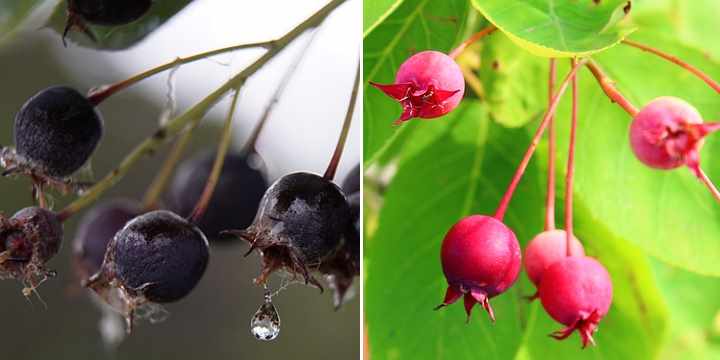
Left picture: mature purple juneberries. Right picture: immature red juneberries
Juneberries are red to dark purple berry-like fruits that grow on deciduous shrubs. The “berries” are a type of pome that looks and tastes like a blueberry. The berries on Amelanchier shrubs measure 0.20” to 0.60” (5 to 15 mm) in diameter. The clusters of dark red to purple berries look attractive, growing amongst small oval leaves.
Juneberries also go by the names serviceberries, sugarplum, chuckley pear, or wild plum. These edible “berries” have a sweet taste with hints of almonds from the seed. You can use the dark-colored berries in baked goods, jams, wine, or pies.
In addition to growing juneberry shrubs for their tasty fruits, they have ornamental value in backyards. The small to large shrubs have white flowers, attractive bark, dark maroon berries, and eye-catching fall colors in shades of vibrant oranges and reds.
Goji Berry (Lycium barbarum or Lycium chinense)
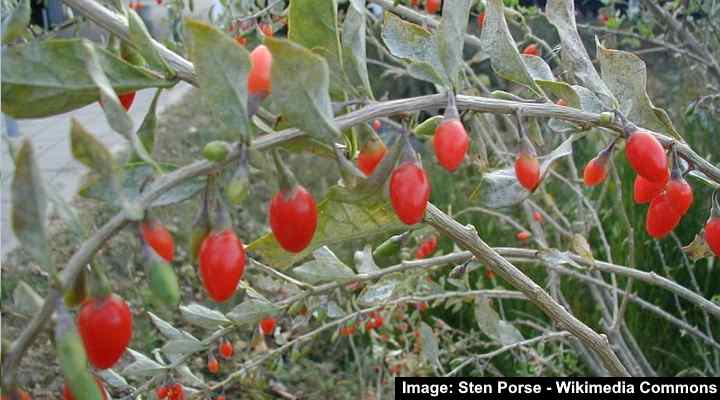
Also called wolfberry, red fruits from goji berry shrubs are bright orange-red, oblong, or ellipsoid berries known as a “superfood.” The bright red berries measure 0.40” to 0.80” (10 – 20 mm) in diameter. The berries grow in groups of two to four fruits and ripen from late summer until the first frost.
Goji berries are most widely used as dried berries and look like wrinkled bright red to dark red raisins. Although there are many claims about the health benefits of goji berries, little scientific evidence supports these.

Dried goji berries
However, like all types of red berries, goji berries contain a range of minerals and vitamins, and other macronutrients, as well as fiber and protein.
Sumac Berry (Rhus spp.)
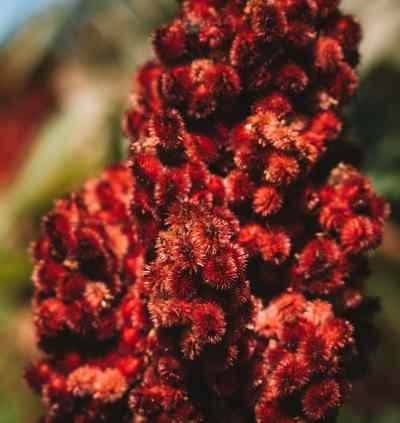
The red berry-like drupes on sumac shrubs and trees grow in dense conical clusters and are ready for harvesting in the fall. Red sumac fruits are recognized by their deep red color and fuzzy appearance. Fruits of sumac plants measure 0.11” to 0.20” (3 – 5 mm) across with up to 700 seeds in a cluster.
The large clusters grow at branch tips and are also called sumac bobs. Typically, sumac fruits are dried and ground into a crimson-colored spice with a tangy flavor. The reddish-purple powder is popular in Middle Eastern cuisine.

The red sumac spice is mainly cultivated from the Syrian sumac (Rhus coriaria) and is commonly used in Middle Eastern cuisine and other spice mixtures
Red Chokeberry (Aronia arbutifolia)
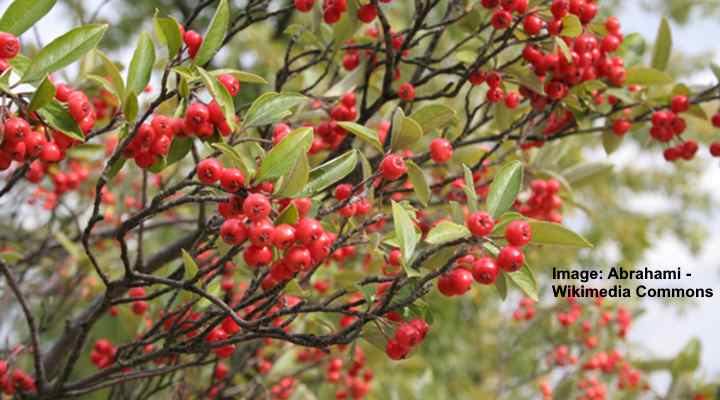
Red chokeberries are glossy red or burgundy edible berry-like pomes with a distinctively tart taste. The bright red berries measure 0.25” to 0.33” (6 – 8.5 mm) in diameter. The showy red fruits grow in abundant clusters on arching stems and persist on the plant from fall through winter.
Although you can eat red chokecherries straight off the shrub, they are usually too bitter and tart to enjoy. In addition, the berries’ astringent taste usually makes your face pucker and mouth dry out. Therefore, red chokeberries are best consumed with other foods in smoothies, jams, jellies, and baked goods.
Coffee Berry (Coffea)
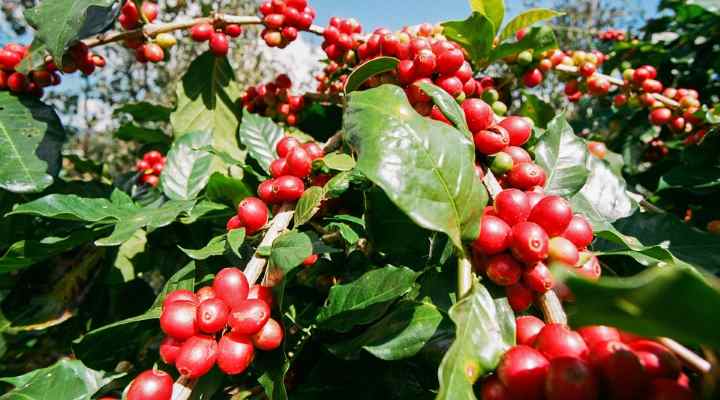
Coffee plants—from where we get coffee beans—produce dark red fleshy berries about the size of small grapes. Also called coffee cherries, the fruit of the coffee plant is, botanically speaking, a berry with sweet, tender, juicy flesh. The berries measure around 0.5” (13 mm) in diameter.
In the center of the coffee berry are two bluish-green seeds, typically roasted to create coffee.
Red coffee berries are usually harvested for their seeds in spring and summer. Although the pulp from coffee beans is edible, it is usually discarded in favor of the “beans” or coffee seeds that are processed and turned into one of the world’s favorite drinks.
Red Grapes (Vitis vinifera)
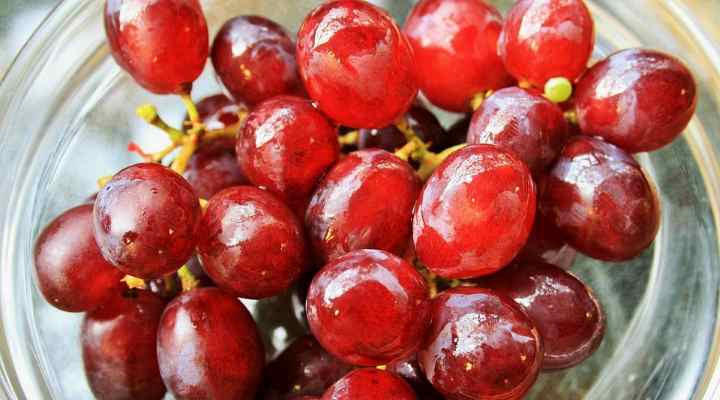
Red grapes are delicious and nutritious dark berries that grow in large bunches on grape vines. The oval-shaped berries can be green, red, burgundy, or deep purple, depending on the cultivar. Bunches of dark red grapes can have between 70 and 300 grapes and weigh, on average, 0.22 lbs. (100 g).
Red grapes are known for their juicy flesh, sweet flavor, and versatility in the kitchen. Grapes are typically consumed fresh or can be processed to make raisins, wine, vinegar, or grape juice. The red berries also contain high levels of anthocyanins—an antioxidant that gives red and dark-colored fruits their color.
Peruvian Peppertree (Schinus molle)
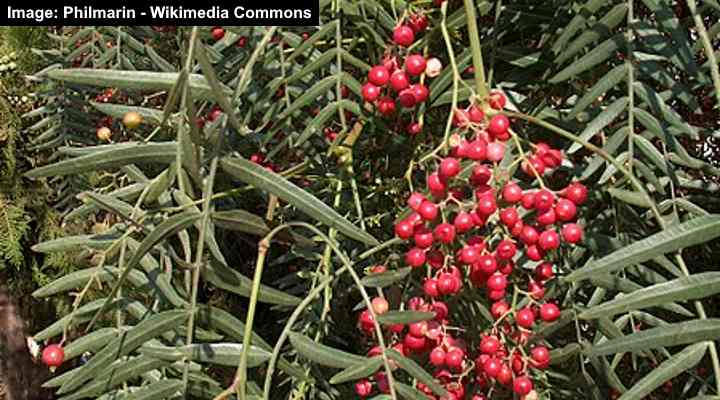
The Peruvian peppertree is an evergreen tree that produces large clusters of red berries containing bright pink, red, or purplish seeds. The colorful seeds of the Peruvian pepper tree have a peppery flavor. Therefore, they are sold as pink peppercorns, even though they are unrelated to black pepper (Piper nigrum).
Also known as California pepper false pepper, or the peppercorn tree, the fruits and seeds are related to cashew plants. You will typically see red peppercorns mixed with black and green peppercorns to create an aromatic pepper mix.
Strawberry Tree (Arbutus unedo)
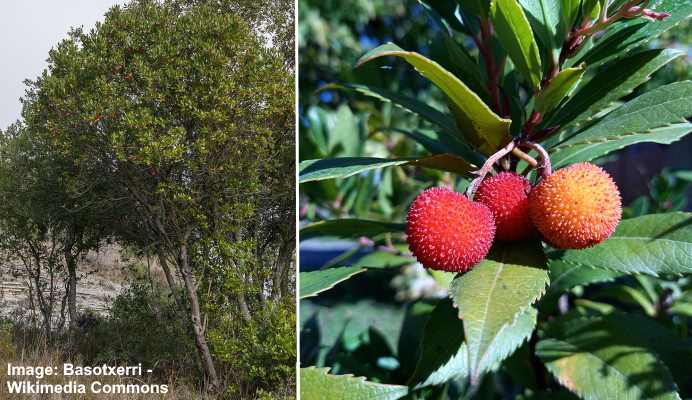
Red berries on strawberry trees are rounded edible fruits resembling strawberries. The fruits on a strawberry tree measure 0.27” to 0.80” (7 – 20 mm) in diameter. The berries have a rough, bumpy texture and a slightly sweet and tangy taste. The bright red berries ripen by late fall and early winter.
Strawberry tree berries are sweet and full of vitamins. In countries where the ornamental plants are common, the edible berries are used to make jams, jellies, and liqueurs. In addition, strawberry trees also have ornamental value, with their globular dark pink and red berries contrasting with evergreen foliage, gnarled branches, and cinnamon-brown peeling bark.
Bearberry or Kinnikinnick (Arctostaphylos uva-ursi)
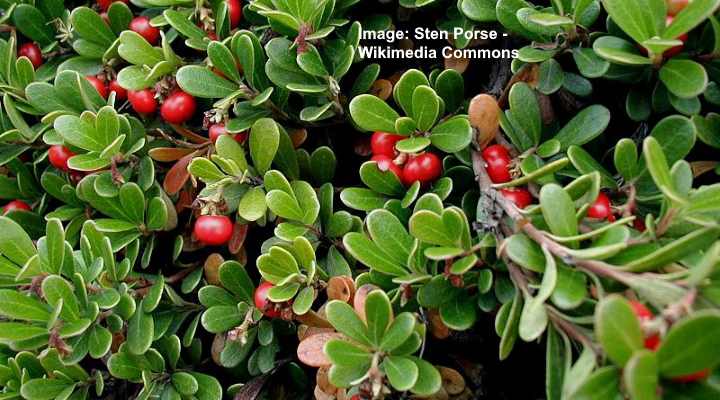
Bearberry is a genus of low-growing, ground cover shrubs that produce small, round red berries with glossy skins. The round berries measure 0.24” to 0.51” (6 – 13 mm) in diameter and are bright red when ripe. They have a mealy flesh with a tart, slightly bitter taste when fresh but become sweeter when boiled.
Although called bearberry, the shiny red fruits are drupes, not berries in the botanical sense. However, their bright red colors contrast with the evergreen foliage, creating visual interest in garden landscapes from fall through winter. Typical uses for red bearberries include making jellies or using them in meat stews.
Rose Hip (Rosa)
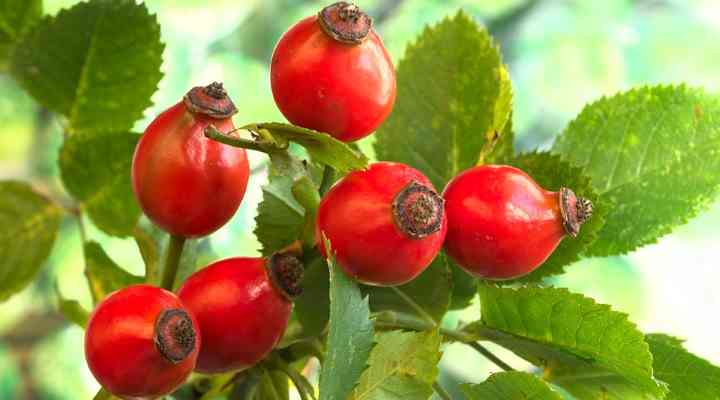
Rose hips are the fruit of rose plants that are a bright red to orange color. The large berry-like red seed-filled pods can be oval or round and appear on rose bushes after flowering. The red fruits measure around 0.5” (13 mm) in size.
You can eat rose hips raw if you take care to avoid the irritating hairs inside the fruits. Traditional uses for rose hips include rose hip syrup, jam, oil, or wine.
High Bush Cranberry (Viburnum trilobum)
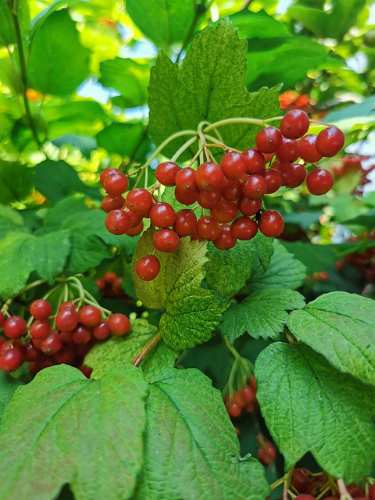
High bush cranberries are bright red, edible berry-like drupes that grow on deciduous shrubs. The red berries are oblong, measuring 0.60” (15 mm) long and 0.47” (12 mm) wide. The common name of the berry-producing plant comes from the red berries that look and taste like cranberries.
Red fruits from the high bush cranberry shrub have a tart, sour flavor that makes them ideal for use in jams, jellies, sauces, and baked goods. After removing the large seeds, you can consume the fruits raw from the shrubby bush.
In addition to their tart red berries, high bush cranberry shrubs have ornamental value in landscaping. They have attractive lobed leaves that turn from green to deep red or purple shades in the fall. In addition, the red berries are tastiest when harvested after frost.
Hobblebush (Viburnum lantanoides)
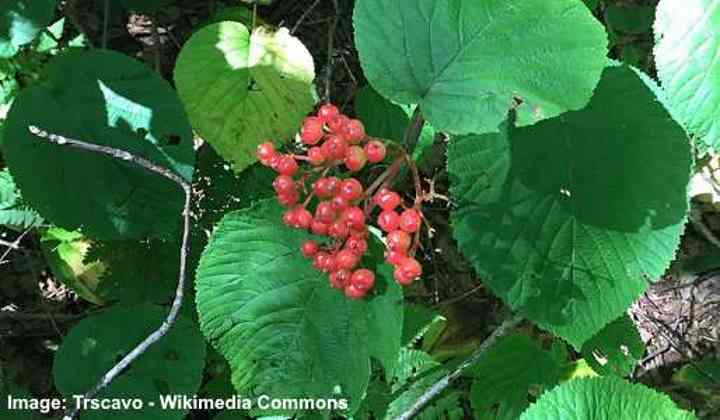
Hobblebush is a perennial shrub that produces clusters of white flowers that develop into edible red berries that eventually ripen to purple. The bright red berries are about 0.33” (8.5 mm) in diameter and grow on arching branches. An attractive feature of the shrub is its heart-shaped leaves growing oppositely on thin stems.
Hobblebush edible berry-like drupes taste slightly sweet, resembling dates, prunes, or raisins. Although the contrast of the red berries and green leaves looks attractive, it’s best to wait until the berries are deep purple after the first frost before consuming them raw. However, due to the seed size, there isn’t much flesh on these tasty drupes.
Cornelian Cherry Dogwood Berry (Cornus mas)
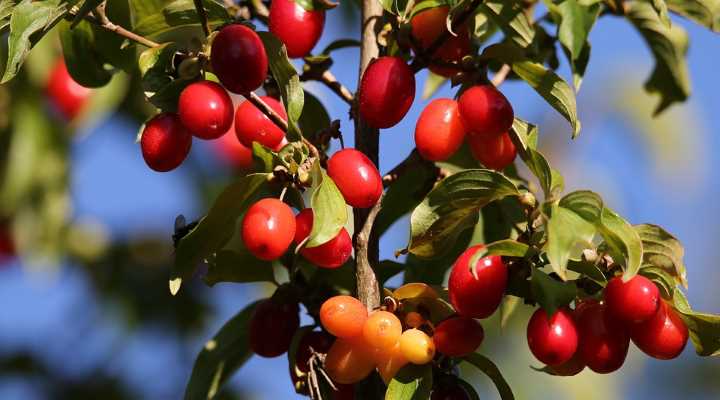
Cornelian cherry dogwood berries are slightly oval, red drupes that look like coffee cherries. The edible ruby-red berries fruits grow amongst dense foliage on woody stems. These round scarlet fruits, like sour cherries and cranberries, have an acidic taste. Cornelian cherries are 0.80″ (20 mm) long and 0.60″ (15 mm) in diameter.
The cherry-like drupes are typically used in Eastern European cooking. In addition, the drupes are popular for making jam, pickles, or, in some countries, vodka. However, cornelian cherry dogwood shrubs have ornamental value besides their culinary uses. The shrubs blossom with showy yellow flowers in winter and bright red or pinkish-red fall foliage.
Winterberry (Ilex verticillata)
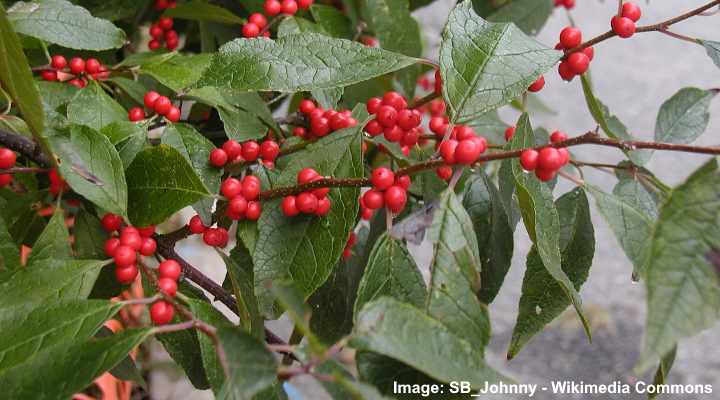
Several varieties of holly shrubs have bright red berries, and winterberry is no exception. The showy red berry-like drupes appear in the fall and winter. They grow on wood branches among glossy, evergreen foliage and measure 0.25” to 0.31” (6 – 8 mm) in diameter, growing in dense clusters along the stems.
Winterberry is grown in landscapes as an ornamental shrub where its berries fill bare winter landscapes with red colors. It’s common to see branches covered in red berries throughout winter.
Winterberry fruits can be eaten by animals and birds; however, they are unsuitable for human consumption.
American Holly (Ilex opaca)
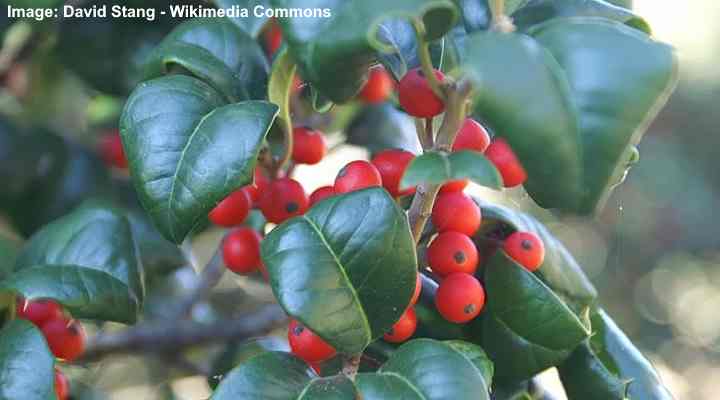
American holly trees are known for their bright red berries and spiny evergreen leaves. The red berries are drupes that grow in clusters from fall and persist through winter. Each small red berry-like fruit measures 0.24” to 0.47” (6 – 12 mm) in diameter. The red berries are poisonous and shouldn’t be consumed.
The evergreen American holly trees with red berries are native to the eastern and south-central United States. Although you cannot eat the red berries, the attractive ornamental trees are valuable for their evergreen foliage, bristle-tipped leaves, and red berries.
Butcher’s Broom (Ruscus aculeatus)
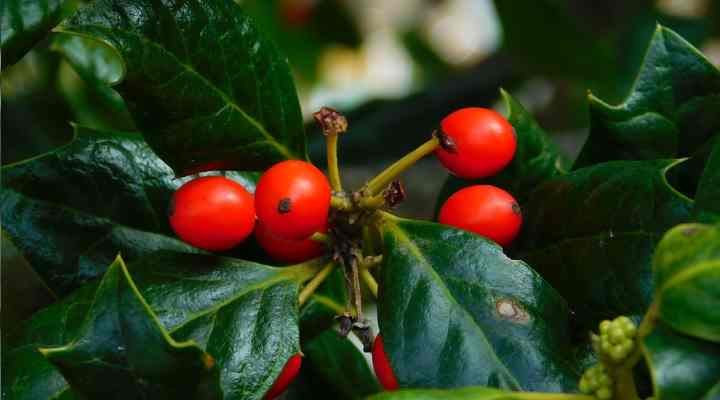
Butcher’s broom is a type of small evergreen shrub that produces greenish flowers that develop into small red pea-shaped berries. The thick, stiff red fruits measure 0.4” (10 mm) in diameter. The berries grow on modified stems called cladophylls that look like petals or holly leaves.
Butcher’s broom red berries are not edible. However, the waxy red berries contrasting with evergreen foliage provide plenty of year-long interest. Because the spiny shrubs don’t grow over 3 ft. (1 m), you can grow the plants as a foundation planting, low-growing hedge, or border shrub.
Cotoneaster (Cotoneaster)
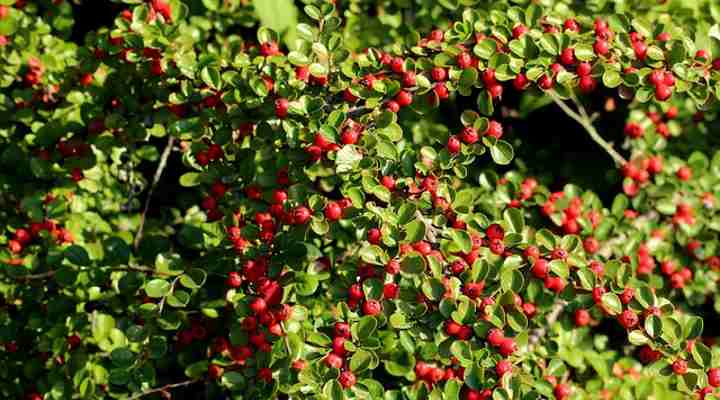
Low-growing cotoneaster shrubs produce bright red berries that appear in the fall and persist through winter. The woody shrubs, with their evergreen foliage of small oval leaves, are ideal for evergreen ground cover. The bright red berry-like pomes measure 0.20” to 0.47” (5 – 12 mm) in diameter.
Cotoneaster plants with their red berries are typically used for ornamental purposes. The masses of decorative red pomes add color and texture to gardens and landscapes. Typically, red cotoneaster berries are a food source for birds and other wildlife during winter.
Bush Honeysuckle (Lonicera tatarica)
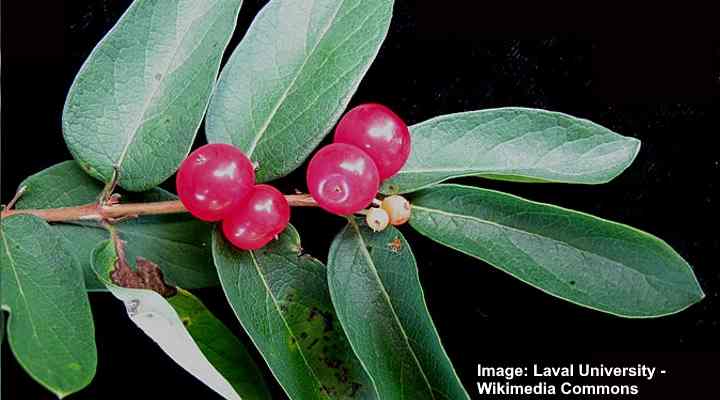
Bush honeysuckles are deciduous shrubs that produce clusters of bright red berries that are edible but not very palatable. The small, round berries measure around 0.2” (5 mm) in diameter and are covered in a thin layer of skin. The berries have a bitter taste and can cause gastrointestinal upset if eaten.
Although bush honeysuckle berries are not commonly eaten, they are still an important food source for birds and other wildlife. In addition, the shrubs are often grown for their ornamental value, with their attractive flowers and foliage adding color and texture to gardens and landscapes.
Bittersweet Nightshade (Solanum dulcamara)
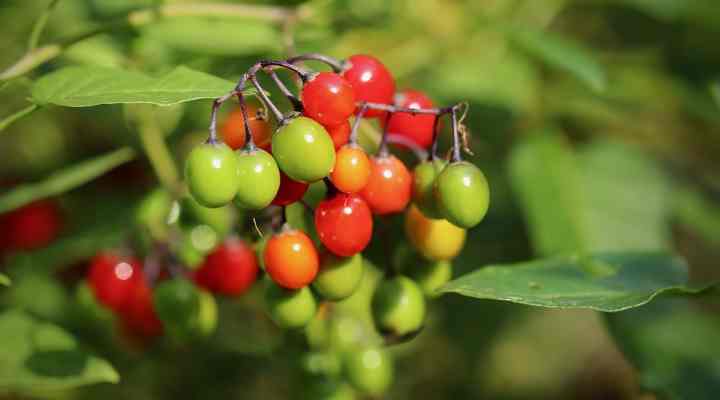
Bittersweet nightshade red berries grow on the perennial vining stems of this vining shrub. The abundant shiny red berries appear in summer and fall. The berries have juicy flesh and the redness of a ripe tomato. Unfortunately, despite their appealing appearance, red berries from bittersweet nightshade are highly poisonous.
Also called woody nightshade, trailing nightshade, and blue bindweed, the vining plant with its egg-shaped red fruits is poisonous. The ovoid berries measure around 0.40” (10 mm) long. Although toxic to humans, pets, and most animals, the berries are an important food source for some birds.
Spindle (Euonymus europaeus)
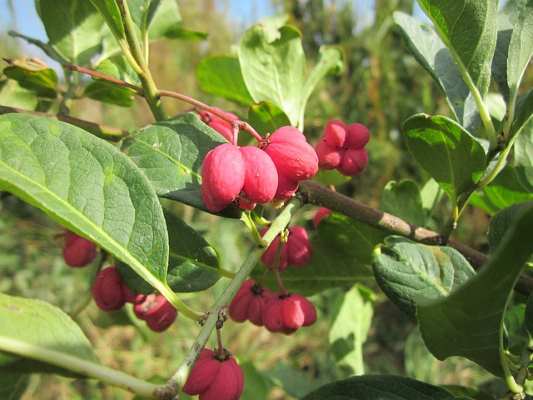
Spindle, or European spindle, is a deciduous shrub that produces small red berry-like fruits in the fall. The fruits are bright red with a pinkish tinge and measure around 0.40” (10 mm) in diameter. The round pinkish-red berries grow in clusters with an open end, giving them a unique appearance.
Spindle red berries are toxic and should not be consumed. In addition, ingesting the red berries can cause vomiting and diarrhea. Instead, spindle shrubs are grown for their ornamental value. They have attractive foliage and showy fruits that persist on the plant well into the winter.
Red Berry Mistletoe (Viscum cruciatum)

Red berry mistletoe is a type of parasitic plant that produces poisonous, deep red berries. You will see clumps of red berry mistletoe growing high up on the branches of trees. This gives the red-berry plant the appearance of a bird’s nest. The small round dark red berries grow up to 0.40” (10 mm) in diameter.
Red berry mistletoe fruits are highly poisonous. However, maroon or wine-red berries are a favorite of birds, usually the primary means of dispersion. You will usually find red-berried mistletoe growing on olive trees and hawthorn trees.
The only use for this ornamental plant is as decoration during the winter holidays. However, mistletoe with white berries is the more traditional Christmas decoration.
Lily of the Valley (Convallaria majalis)
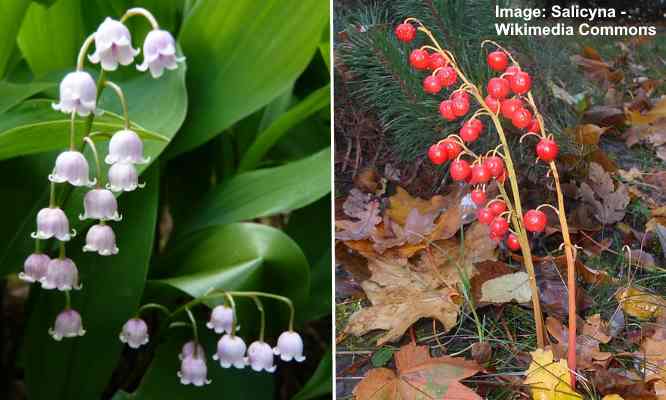
Lily of the valley is a woodland flowering plant with bell-shaped, fragrant white flowers and small, orange-red berries. The red berries are round and measure 0.2” to 0.3” (5 – 7 mm) in diameter. They grow on stems that emerge from the plant’s base, just above the ground.
Lily of the valley is primarily grown for its fragrant white flowers. And although the small shade-loving plant produces red berries, the red fruits only develop in optimal conditions. Therefore, few people realize that the lily of the valley has round red berries growing on nodding stems.
It’s important to remember that all parts of lily of the valley are toxic. This includes its red berries, urn-shaped white flowers, and lanceolate leaves. Therefore, you must treat the plant carefully if you grow it as ground cover, perennial borders, or in containers.
Red Baneberry (Actaea rubra)
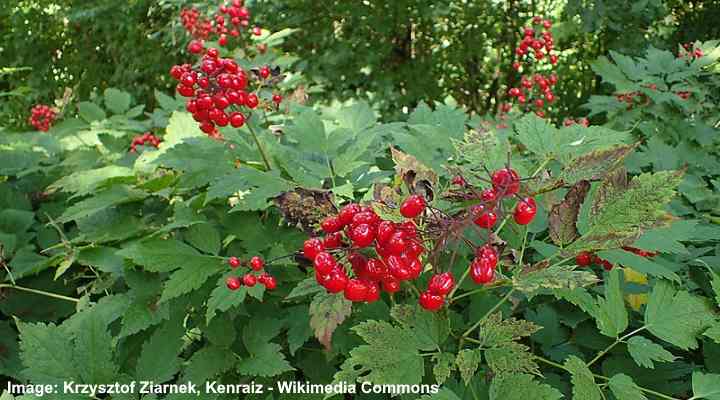
Red baneberries are small, bright red, or pinkish-red toxic berry-like fruits that grow on perennial herbaceous plants. The round berries ripen to bright red in the summer and have a distinctive dark dot on them. The red baneberries have an ellipsoid shape, measuring 0.33” to 0.40” (8.5 – 10 mm) in diameter and growing in clusters on reddish stems.
While the red baneberry may look tempting to eat, it’s important to note that all parts of the plant, including its red berries, are toxic. However, you can use the low-growing flowering plant as ground cover in the shade.
Yew Berry (Taxus baccata)
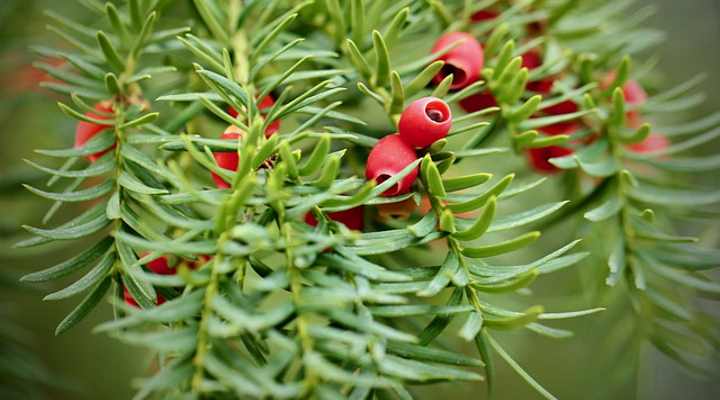
Evergreen yew trees produce unusual red seed cones that look like small berries. The cones develop a bright red aril—a fleshy, berry-like structure surrounding a single seed. The red berry-like aril measures 0.31” to 0.60” (8 – 15 mm) long and has an open end. Although all parts of yew trees are poisonous, the fleshy part of the red aril has a sweet, palatable taste.
Yew trees are rarely grown for their bright red berries. However, the evergreen trees have several uses in a landscape, including a specimen plant, foundation planting, evergreen hedge, or upright columnar tree. Yew shrubs are also valuable as ground cover plants or decorative privacy screens.
Related articles:
